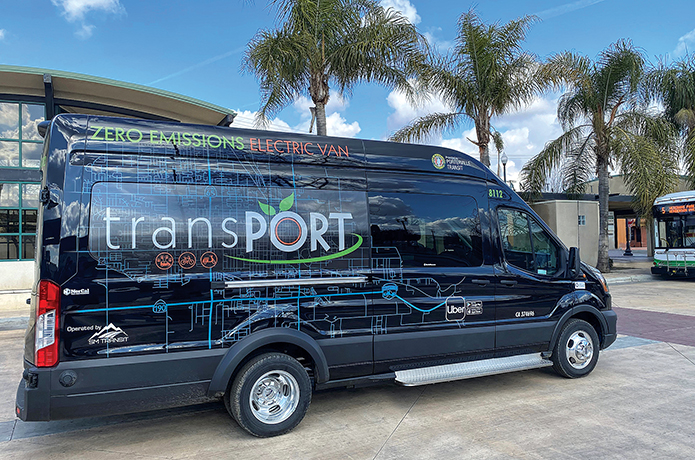
In the spirit of sustainable community transit, the City of Porterville, California, added 12 all-electric micro-transit vans to its fleet in January.
The decision to embrace sustainable micro-transit resulted from an internal analysis at the Porterville Transit System. First, the agency wanted to replace low-performing fixed routes with routes focused on improved mobility and a more direct approach. Secondly, the agency saw an opportunity to expand mobility into areas which were previously not served – due to either lower ridership or poor connectivity to standing fixed routes.
“It came down to not only providing better mobility within our community, but also expanding our service area,” said Richard Tree, transit administrator at Porterville Transit System.
Tree said the deployment resulted from an informal bid after the agency reviewed the Class 3 Lightning Electric Transit Van by Lightning eMotors. Terry Scholl, business development manager for Lightning eMotors, said the company developed the vans on the Ford Transit 350 HD chassis.
NorCal Vans/Driverge of Chico, California, upfitted the fans to meet ADA requirements, per Porterville’s specifications.
The vehicle features a range of 120 miles of travel between charges. If the daily mileage requirement exceeds 120 miles, the vehicle allows for a fast charge that will allow for a 50 percent charge in approximately 45 minutes. The vehicle accommodates between 10 and 16 passengers, depending on wheelchair configuration,
“As the van operates, it moves quietly through communities without making a lot of noise and without any emissions,” Scholl said. “Since the vehicle operates on the Ford Transit chassis – one of the most widely sold van products on the market – customers can take advantage of the all-electric setup without forgoing the convenience of their local Ford dealer for service requirements.”
Embracing Micro-Transit
When explaining the micro-transit concept to local officials, Tree said it helped to compare the service to on-demand applications like Uber or Lyft – embracing technology which allowed for quick-trip scheduling, real-time notifications, and efficient routing software.
“Sustainability is also vitally important to us, and we saw this as a great opportunity to test this concept and its cost-effectiveness,” Tree said.
After a year into the micro-transit operation, Tree said the city is extremely pleased with the community’s acceptance. Ridership has increased month after month, he said, dating back to April of 2020. Furthermore, the agency is pleased with the micro-transit service’s cost-effective operations.
“We have seen an interesting phenomenon,” Tree added. “The service was not necessarily intended to hyper-focus on disabled or senior populations, but many of those riders have gravitated toward the micro-transit model. A high percentage of people have moved from Dial-A-Ride to the on-demand service, which allows for additional capacity in our paratransit vehicles.”
The vehicles accommodate either a rear-wheelchair arrangement – as found on Porterville’s vans – or can operate
with an optional side-door to accommodate both ambulatory and non-ambulatory passengers.
Scholl said that Porterville opted for a higher roof height – an option on these vehicles – and passengers have expressed appreciation. Passengers can board without bending over, stand up, and access grab rails.
Expanding the Service
The service has performed so well in Porterville, Tree said, that local officials are eager to expand micro-transit to each of the county’s eight operators.
“We expect on-demand service, with these electric vehicles, to expand throughout the county within this next year or this calendar year,” he said.
In May, Porterville will launch a new partnership with Uber. Tree said the city hopes to take advantage of Uber’s software-as-a-service (SaaS) and global brand in order to take on-demand transit to the next level.
“People are coming to understand Uber as second nature,” Tree said. “Our services will be accessible via the Uber app, and riders can make informed decisions on the best trips for them. Then they can pay within that same Uber app. of what the cheapest trip option is, and they can pay for their ride, all within the Uber app. It is a truly an exciting time for transit in our county.”
